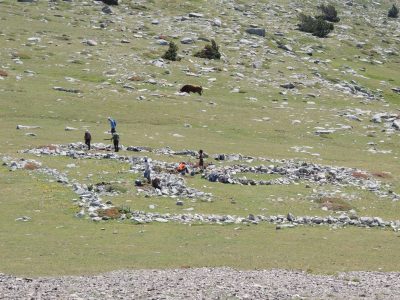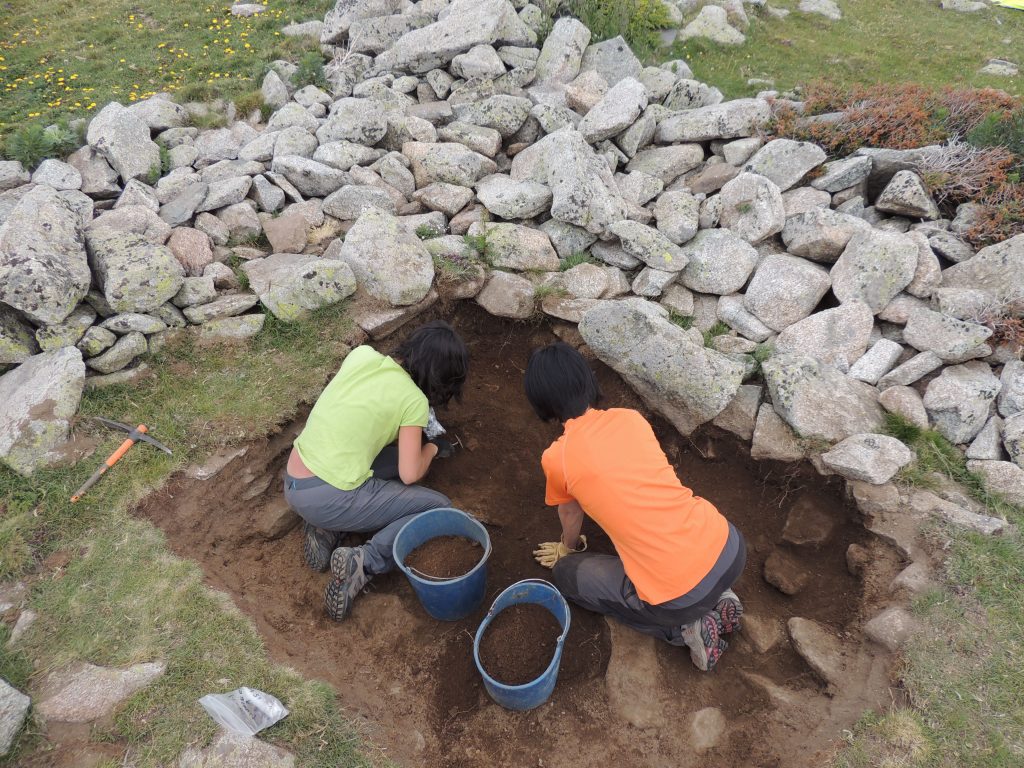
ICAC archaeological surveys in the area (carried out since 2018) raised the possibility of a military settlement at an altitude of 2,500 m.
Meranges City Council and the Catalan Institute of Classical Archaeology (ICAC) have reached an agreement to reactivate this summer the archaeological works at Coll de Molleres site (Cerdanya), the highest Roman site discovered so far in Catalonia, at 2,500 metres above sea level. The project thus enters a second stage, after the first surveys within a wider investigation in which the municipalities of Guils and Lles, in La Cerdanya, were also involved.
⇒ Journalist Miquel Spa reports on this project in Regió7 news (May 16, 2022).
The archaeological works carried out by the GIAP research group (ICAC) focus on the study of human occupation, from the Neolithic period onwards but especially the Roman period, around and above an altitude of 2,000 m. The Roman site at Coll de Molleres would unseat another site in the Vansa and Fórnols valley (Cadí mountain range), at an altitude of 2,000 m, as the highest in the country.
At this site located in an area known as Goleró, GIAP archaeologists found evidence of military metallurgical exploitation from the Roman period that has been stated as very important by the ICAC.
ICAC director, Josep Maria Palet, explained that “this site in Coll de Molleres has surpassed that of El Goleró because we are working in a site which probably dates from a similar chronology as the Roman city of Iulia Libica in Llívia, but which is at 2,500 m and is, therefore, the highest in Catalonia”.
Palet also pointed out that, in the same way as the Vansa site, the Meranges site may also have been a strategic control point for the passage of troops through the Pyrenees: “It was probably a small military settlement with a quadrangular structure”, and he announced that “this summer we will begin to excavate it extensively”.
Four years of GIAP archaeological works in the Pyrenees
Thus, the Meranges City Council and the Catalan Institute of Classical Archaeology (ICAC), through the GIAP group, will now activate a four-year archaeological excavations project that will leave behind the different survey tasks carried out since 2018. Coll de Molleres site is located on land owned by the City Council, which has expressed its willingness to promote the archaeological investigations.
The archaeological works will be directed by GIAP researchers Dra. Lídia Colominas (Ramón y Cajal researcher), Arnau Carbonell (PhD researcher), and Dr. Josep Maria Palet (co-director of GIAP and ICAC director).

Related news:
«Meranges excavarà un jaciment romà que serà el més alt del país», Regió7, 16 de mayo de 2022.
«New archaeological works in the prehistoric cave 338 in the Pyrenees», ICAC, September 2, 2021.
Campaña 2019: «Archaeo-tracks: hiking through archaeological interest sites. An exemple of knowledge transfer»
Campaña 2018: “Arqueologia dels paisatges culturals de muntanya a les capçaleres del Ter i del Segre (Ripollès-Cerdanya)”
Campaña 2017: “Primers passos per posar en valor el patrimoni arqueològic de les capçaleres del Ter i Freser”
Campaña 2016: “Voldríem donar vida al patrimoni arqueològic del Pirineu”
Campaña 2015: “Tenim un nou gran assentament ramader d’alçada del Neolític”
“Cinc mil anys de transhumància al nord-est de Catalunya” (Catalunya Ràdio, 6/10/2015)
Campaña 2014: “A la plana litoral empordanesa el paleosòl antic pot estar a 15 metres de profunditat”
“La geoarqueologia permet integrar arqueologia i paleoambient”
Campaña 2013: “El model ciutat-territori romà també es va instal·lar al Pirineu”
Campaña 2012: “En època romana el Pirineu oriental el connecta l’activitat minerometal·lúrgica”
Campaña 2011: “Hem documentat hàbitat d’època romana a alta muntanya per primera vegada”
Campaña 2010: “Volem explicar la relació històrica plana-muntanya a través de la transhumància al NE de Catalunya”





